MacDon 9250 SP User Manual

9250/9350/9352 SELF-PROPELLED WINDROWER
OPERATOR’S MANUAL
Form 46584 Issue 11/06 Web Rev_01
Sugg. Retail: $25.00

CALIFORNIA
Proposition 65 Warning
Diesel engine exhaust and some of its constituents are known to the State of California to cause cancer, birth defects, and other reproductive harm.
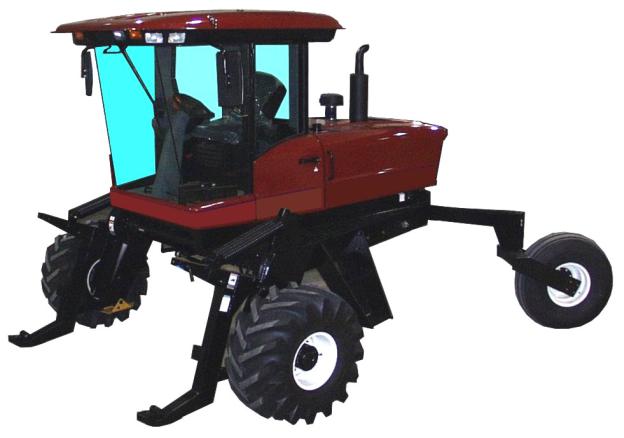
INTRODUCTION
Your new Self-Propelled Windrower is designed to cut and lay in windrows, a wide variety of grain, hay and specialty crops. Windrowing allows starting the harvest earlier, protects the crop from wind damage, and gives you more flexibility in scheduling combine time.
The power unit (referred to in this manual as the "tractor"), when coupled with one of the specially designed draper or auger headers, provides a package which incorporates many features and improvements in design requested by Owner/Operators like yourself.
NOTE: This manual contains information on the windrower tractor only. It is to be used in conjunction with the Header Operator's Manual.
CAREFULLY READ BOTH MANUALS TO BECOME FAMILIAR WITH ALL RECOMMENDED PROCEDURES BEFORE ATTEMPTING TO UNLOAD, ASSEMBLE OR USE THE WINDROWER.
Use the manual as your first source of information about the machine. If you follow the instructions given in this manual, your Windrower will work well for many years.
The manual contains instructions for "Safety", "Operation", and "Maintenance/Service". In addition "Unloading and Assembly" information is given towards the back of this book.
Use the Table of Contents and the Index to guide you to specific areas. Study the Table of Contents to familiarize yourself with how the material is organized.
Keep this manual handy for frequent reference and to pass on to new operators or owners. Call your Windrower dealer if you need assistance, information, or additional copies of the manuals.
NOTE: Right hand (R/H) and left hand (L/H) designations are determined from the operator's position, facing forward.
Form # 46584 |
1 |
Issue 11/06 Web Rev_01 |
|
|
TABLE OF CONTENTS |
|
|
PAGE |
INTRODUCTION........................................................................................................................................... |
1 |
SERIAL NUMBER LOCATIONS ................................................................................................................... |
5 |
SAFETY |
|
Safety Alert Symbol ................................................................................................................................ |
6 |
Signal Words .......................................................................................................................................... |
6 |
Safety Signs ........................................................................................................................................ |
7,8 |
General Farm Safety ......................................................................................................................... |
9,10 |
SPECIFICATIONS |
|
Tractor .................................................................................................................................................. |
11 |
Engines................................................................................................................................................. |
12 |
Hardware Torque Specifications .......................................................................................................... |
13 |
Hydraulic Fitting Torque Specifications ................................................................................................ |
14 |
OPERATOR'S STATION |
|
Symbol Definitions.......................................................................................................................... |
15, 16 |
Mac Monitor.................................................................................................................................... |
17, 18 |
Operator Presence System .................................................................................................................. |
19 |
Gauges ................................................................................................................................................. |
19 |
Speedometer ........................................................................................................................................ |
19 |
Ignition Switch ...................................................................................................................................... |
20 |
Lights .................................................................................................................................................... |
20 |
Cab Temperature Controls ................................................................................................................... |
21 |
Windshield Wiper Control ..................................................................................................................... |
21 |
Windrower Controls .............................................................................................................................. |
22 |
Header Controls ............................................................................................................................ |
23 - 25 |
Seat Belts ............................................................................................................................................. |
25 |
Seat Adjustments ................................................................................................................................. |
26 |
Operator Amenities............................................................................................................................... |
27 |
OPERATION |
|
Your Responsibilities as an Owner/Operator ....................................................................................... |
28 |
To the New Operator ............................................................................................................................ |
28 |
Break-In Period..................................................................................................................................... |
29 |
Pre-Starting Checks: Annual ................................................................................................................ |
30 |
Pre-Starting Checks: Daily ................................................................................................................... |
31 |
Start-Up Procedure......................................................................................................................... |
32, 33 |
Driving the Windrower |
|
Safety............................................................................................................................................. |
34 |
To Drive Forward ........................................................................................................................... |
35 |
To Drive Rearward......................................................................................................................... |
36 |
Making a Spin Turn........................................................................................................................ |
37 |
Stopping Procedure |
|
To Stop Windrower ........................................................................................................................ |
38 |
To Stop Engine .............................................................................................................................. |
38 |
Leaving the Windrower......................................................................................................................... |
39 |
Emergency Exit.............................................................................................................................. |
39 |
Attaching the Header..................................................................................................................... |
40 - 42 |
Adding Rear Weight ....................................................................................................................... |
43, 44 |
Detaching the Header..................................................................................................................... |
45, 46 |
Operating the Header ........................................................................................................................... |
47 |
Header Lift Cylinder Stops.................................................................................................................... |
47 |
Header Angle........................................................................................................................................ |
48 |
Header Levelling................................................................................................................................... |
49 |
Header Flotation ................................................................................................................................... |
50 |
Transporting the Windrower |
|
Driving on Roads ........................................................................................................................... |
51 |
Form # 46584 |
2 |
Issue 11/06 Web Rev_01 |
|
|
TABLE OF CONTENTS |
|
OPERATION |
PAGE |
Transporting the Windrower (continued) |
|
Towing With a Trailer............................................................................................................... |
52, 53 |
Towing without a Trailer........................................................................................................... |
54, 55 |
Storage Procedure ...................................................................................................................................... |
56 |
MAINTENANCE/SERVICE |
|
Service Procedures ............................................................................................................................ |
57 |
Seat Belt Inspection and Maintenance ............................................................................................. |
58 |
Operator Presence System................................................................................................................ |
58 |
R/H Step Ladder Use & Storage ........................................................................................................ |
58 |
Fuels, Fluids and Lubricants |
|
Diesel Fuel..................................................................................................................................... |
59 |
Engine Coolant .............................................................................................................................. |
59 |
Grease ........................................................................................................................................... |
59 |
Hydraulic Oil................................................................................................................................... |
59 |
Engine Oil ...................................................................................................................................... |
60 |
Bevel Gear Box Lubricant.............................................................................................................. |
60 |
Power Wheel Gear Lubricant......................................................................................................... |
60 |
Storing Lubricants.......................................................................................................................... |
60 |
System Capacities ......................................................................................................................... |
60 |
Greasing the Windrower Tractor .................................................................................................. |
61 - 63 |
Diesel Engine |
|
Cummins Barring Tool ................................................................................................................... |
64 |
Opening and Closing Hood............................................................................................................ |
64 |
Lubricating Oil.......................................................................................................................... |
65, 66 |
Belts............................................................................................................................................... |
66 |
Engine Speed: Throttle Rod Adjustment (Naturally Aspirated)...................................................... |
67 |
Engine Speed: Throttle Rod Adjustment (Turbo)........................................................................... |
68 |
Valve Tappet Clearance ................................................................................................................ |
68 |
General Engine Inspection............................................................................................................. |
68 |
Diesel Engine Air Intake System: Air Cleaner............................................................................. |
69, 70 |
Diesel Engine Fuel System |
|
Storing Fuel.................................................................................................................................... |
71 |
Refuelling Windrower..................................................................................................................... |
71 |
Fuel Tank Venting.......................................................................................................................... |
71 |
Fuel Sediment Bowl....................................................................................................................... |
72 |
Fuel Water Separator..................................................................................................................... |
72 |
Fuel Filters ..................................................................................................................................... |
73 |
Fuel System Air Removal ........................................................................................................ |
74, 75 |
Engine Exhaust System: Muffler........................................................................................................ |
76 |
Engine Cooling System |
|
Coolant Level................................................................................................................................. |
77 |
Radiator Cap.................................................................................................................................. |
77 |
Anti-Freeze Concentration............................................................................................................. |
77 |
Changing Coolant .......................................................................................................................... |
78 |
Screens and Coolers ..................................................................................................................... |
79 |
Electrical System |
|
Battery..................................................................................................................................... |
80 - 82 |
Preventing Alternator and Regulator Damage............................................................................... |
83 |
Lights and Bulbs ..................................................................................................................... |
84 - 87 |
Circuit Breakers ............................................................................................................................. |
88 |
Electrical Schematics.................................................................................................... |
back of book |
Hydraulic System |
|
Safety............................................................................................................................................. |
89 |
Hydraulic Oil Cooler....................................................................................................................... |
89 |
Hydraulic Oil & Filters .............................................................................................................. |
89, 90 |
Form # 46584 |
3 |
Issue 11/06 Web Rev_01 |
|
|
TABLE OF CONTENTS |
|
|
PAGE |
MAINTENANCE/SERVICE (continued) |
|
Hydraulic System: Header & Reel Lift |
|
Cylinder Control Valve Relief Pressure ......................................................................................... |
91 |
Header & Reel Lift Hydraulic Schematic....................................................................... |
back of book |
Header Drive: Hydraulics |
|
Flow Control Block......................................................................................................................... |
92 |
Header Drive Relief Pressure ........................................................................................................ |
92 |
Header Drive Hydraulic Schematic............................................................................... |
back of book |
Header Drive |
|
Bevel Gear Box Lubricant.............................................................................................................. |
93 |
Header Drive Belt........................................................................................................................... |
93 |
Header Drive Belt Pulley Alignment......................................................................................... |
94, 95 |
Header Drive Belt Guides & Pulley Shield............................................................................... |
95, 96 |
Traction Drive: Hydraulics |
|
Transmission Oil Pressure............................................................................................................. |
97 |
Charge Pump Pressure ................................................................................................................. |
97 |
Traction Drive Hydraulic Schematic.............................................................................. |
back of book |
Traction Drive: Neutral Lock and Steering |
|
Checks.................................................................................................................................. |
98 - 100 |
Troubleshooting ........................................................................................................................... |
101 |
Neutral Set-Up Procedure.................................................................................................... |
102, 103 |
Traction Drive: |
|
Ground Speed Lever Friction Device........................................................................................... |
104 |
Wheels and Tires................................................................................................................ |
105 - 107 |
Park Brake (models 9250/9350, 4940/4950, 2940/2950, 8140/8150) ......................................... |
108 |
Park Brake (models 9352, 4952, 2952, 8152) ............................................................................. |
109 |
Cab Air System.......................................................................................................................... |
110 - 112 |
MAINTENANCE SCHEDULE ........................................................................................................... |
113, 114 |
MAINTENANCE RECORD ............................................................................................................... |
115, 116 |
TROUBLE SHOOTING |
|
Cab Air System.......................................................................................................................... |
117 - 120 |
Engine ....................................................................................................................................... |
120 - 125 |
Electrical ..................................................................................................................................... |
125, 126 |
Traction Drive System ............................................................................................................... |
126 - 128 |
Steering and Ground Speed Controls ................................................................................................ |
128 |
Header Hydraulics .............................................................................................................................. |
129 |
Header Drive ............................................................................................................................. |
129 - 131 |
Park Brake.......................................................................................................................................... |
131 |
Operator's Seat................................................................................................................................... |
131 |
OPTIONS AND ATTACHMENTS ............................................................................................................. |
132 |
UNLOADING ..................................................................................................................................... |
133, 134 |
ASSEMBLY |
|
Tires........................................................................................................................................... |
135 - 137 |
Battery ........................................................................................................................................ |
138, 139 |
Adjustments & Checks ....................................................................................................................... |
139 |
Preparing for Harvest Headers.................................................................................................. |
140 - 143 |
Radio & Two-Way Radio Installation .......................................................................................... |
144, 145 |
Tool Box ............................................................................................................................................. |
145 |
Swath Roller Installation ..................................................................................................................... |
146 |
INDEX ........................................................................................................................................... |
147 – 149 |
ELECTRICAL & HYDRAULIC SCHEMATICS .......................................................................................... |
150 |
Form # 46584 |
4 |
Issue 11/06 Web Rev_01 |
|
|
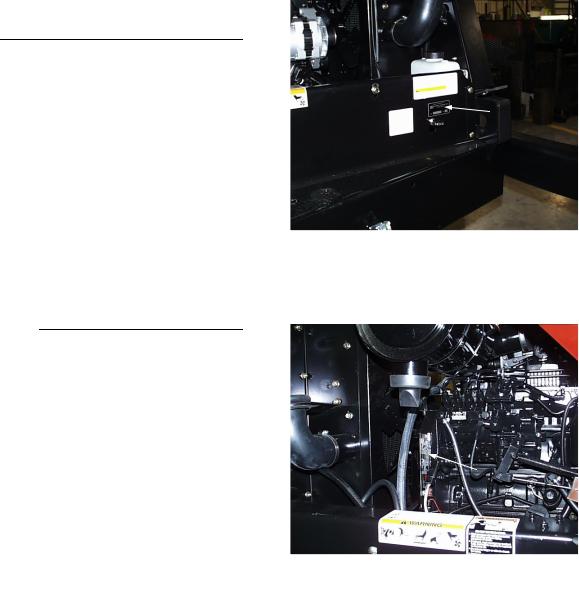
SERIAL NUMBER LOCATIONS
Record the serial numbers in the space provided.
Tractor:
Plate is located on left side of main frame, near rear corner.
Diesel Engine:
Plate is located on right side of block, beside injection pump.
NOTE: When ordering parts and service, be sure to give your dealer the complete and proper serial number. For engine parts, see your local Cummins engine dealer.
TRACTOR SERIAL PLATE LOCATION
DIESEL ENGINE SERIAL PLATE LOCATION
Form # 46584 |
5 |
Issue 11/06 Web Rev_01 |
|
|

SAFETY
SAFETY ALERT SYMBOL
This safety alert symbol indicates important safety messages in this manual and on safety signs on the header.
This symbol means:
ATTENTION !
BECOME ALERT !
YOUR SAFETY IS INVOLVED !
Carefully read and follow the safety message accompanying this symbol.
Why is SAFETY important to you?
· ACCIDENTS DISABLE AND KILL 3 BIG REASONS · ACCIDENTS COST
· ACCIDENTS CAN BE AVOIDED
SIGNAL WORDS
Note the use of the signal words DANGER, WARNING, and CAUTION with safety messages. The appropriate signal word for each message has been selected using the following guidelines:
DANGER – Indicates an imminently hazardous situation that, if not avoided, will result in death or serious injury.
WARNING – Indicates a potentially hazardous situation that, if not avoided, could result in death or serious injury. It is also used to alert against unsafe practices.
CAUTION – Indicates a potentially hazardous situation that, if not avoided, may result in minor or moderate injury. It is also used as a reminder of good safety practices.
Form # 46584 |
6 |
Issue 11/06 Web Rev_01 |
|
|

SAFETY
SAFETY SIGNS
•The safety signs reproduced below appear on the windrower at the locations listed.
•Keep safety signs clear and legible at all times.
•Replace safety signs that are missing or become illegible.
•If original parts on which a safety sign was installed are replaced, be sure the repair part also bears the current safety sign.
•Safety signs are available from your Dealer Parts Department. The part number is printed in the lower R/H corner of each safety sign.
To install safety signs:
1.Be sure the installation area is clean and dry.
2.Decide on the exact position before you remove the backing paper.
3.Remove the smaller portion of the split backing paper.
4.Place the sign in position and slowly peel back the remaining paper, smoothing the sign as it is applied.
5.Small air pockets can be smoothed out or pricked with a pin.
Form # 46584 |
7 |
Issue 11/06 Web Rev_01 |
|
|
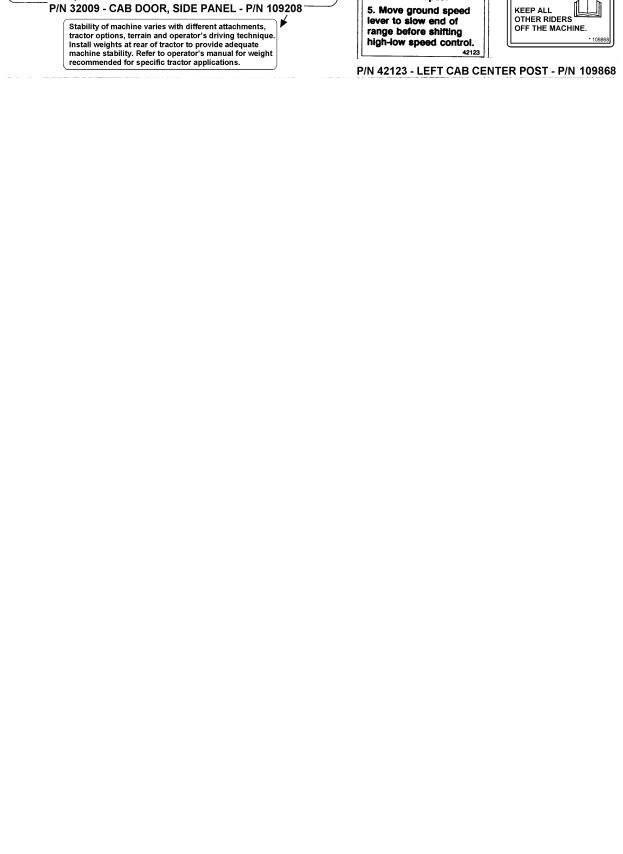
SAFETY
SAFETY SIGNS (continued)
Form # 46584 |
8 |
Issue 11/06 Web Rev_01 |
|
|

SAFETY
GENERAL SAFETY
The following are general farm safety precautions that should be part of your operating procedure for all types of machinery.
1.Protect yourself.
When assembling, operating and servicing machinery, wear all the protective clothing and personal safety devices that COULD be necessary for the job at hand. Don't take chances.
You may need:
·a hard hat.
·protective shoes with slip resistant soles.
·protective glasses or goggles.
·heavy gloves.
·wet weather gear.
·respirator or filter mask.
·hearing protection. Be aware that prolonged exposure to loud noise can cause impairment or loss of hearing. Wearing a suitable hearing protective device such as ear muffs (A) or ear plugs (B) protects against objectionable or loud noises.
2.Provide a first-aid kit for use in case of emergencies.
3.Keep a fire extinguisher on the machine. Be sure the extinguisher is properly maintained and be familiar with its proper use.
4.Keep young children away from machinery at all times.
5.Be aware that accidents often happen when the operator is tired or in a hurry to get finished. Take the time to consider the safest way. Never ignore warning signs of fatigue.
PROTECT YOURSELF
PROTECT AGAINST NOISE
BE PREPARED FOR EMERGENCIES
Form # 46584 |
9 |
Issue 11/06 Web Rev_01 |
|
|
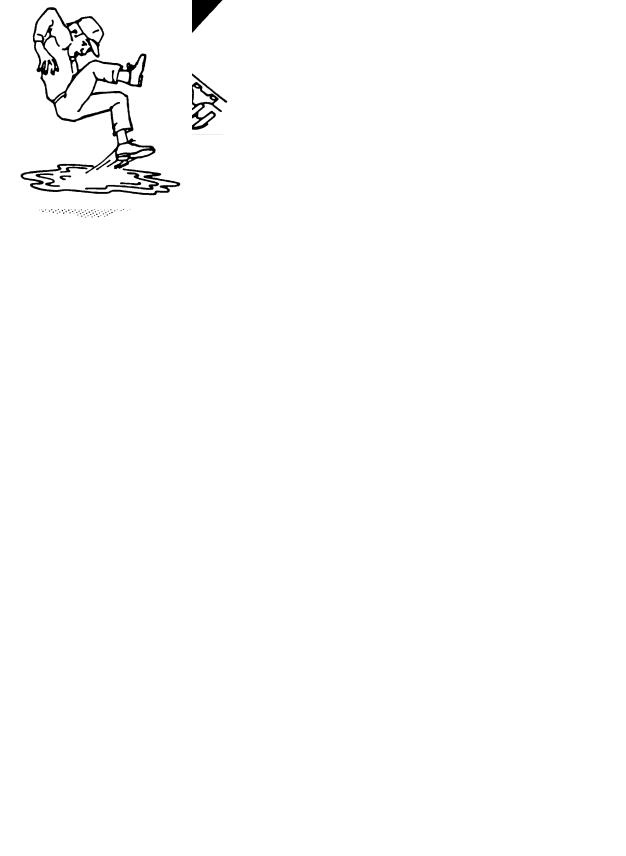
SAFETY
GENERAL SAFETY (continued)
6.Wear close-fitting clothing and cover long hair. Never wear dangling items such as scarves or bracelets.
7.Keep hands, feet, clothing and hair away from moving parts. Never attempt to clear obstructions or objects from a machine while the engine is running.
8.Keep all shields in place. Never alter or remove safety equipment. Make sure driveline guards can rotate independently of the shaft and can telescope freely.
9.Use only service and repair parts made or approved by the equipment manufacturer. Substituted parts may not meet strength, design, or safety requirements.
10.Do not modify the machine. Unauthorized modifications may impair the function and/or safety and affect machine life.
11.Stop engine and remove key from ignition before leaving operator's seat for any reason. A child or even a pet could engage an idling machine.
12.Keep the area used for servicing machinery clean and dry. Wet or oily floors are slippery. Wet spots can be dangerous when working with electrical equipment. Be sure all electrical outlets and tools are properly grounded.
13.Use adequate light for the job at hand.
14.Keep machinery clean. Straw and chaff on a hot engine are a fire hazard. Do not allow oil or grease to accumulate on service platforms, ladders or controls. Clean machines before storage.
15.Never use gasoline, naphtha or any volatile material for cleaning purposes. These materials may be toxic and/or flammable.
16.When storing machinery, cover sharp or extending components to prevent injury from accidental contact.
NEVER WEAR LOOSE OR DANGLING
CLOTHES
KEEP AWAY FROM MOVING PARTS
KEEP SERVICE AREA CLEAN AND DRY
Form # 46584 |
10 |
Issue 11/06 Web Rev_01 |
|
|
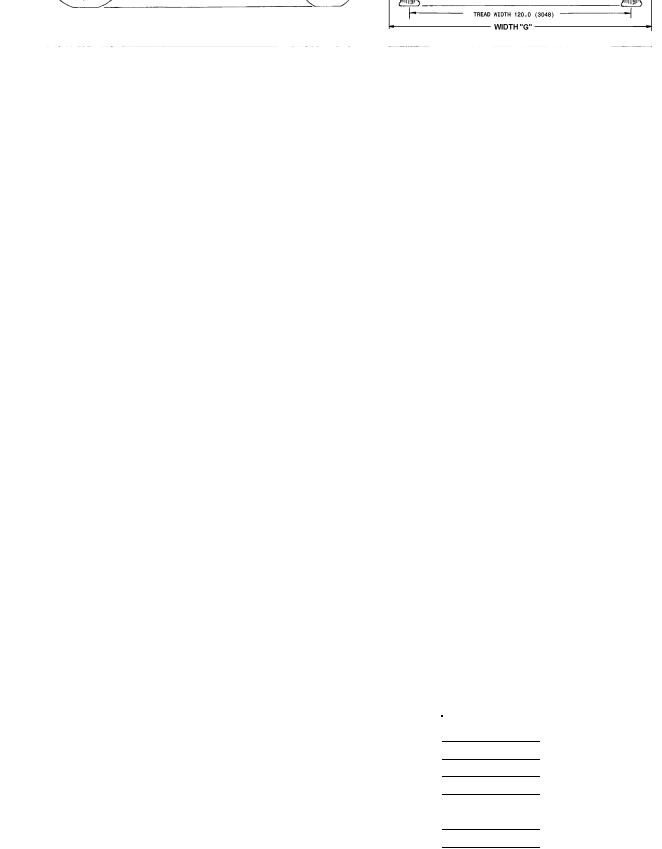
SPECIFICATIONS
TRACTOR DIMENSIONS: |
|
Weight (varies with tire size): |
approx. 7225 lbs. (3275 kg) |
- with naturally-aspirated (N/A) diesel engine ............................................... |
|
- with turbocharged diesel engine ................................................................. |
approx. 7250 lbs. (3290 kg) |
Drive Tire |
21.5L - 16.1 |
|
14.9 - 24 |
|
|
500-70R24 |
|
540 - 65R24 |
560 - 65D24 |
|
Tread Width A |
118.1" (3000 mm) |
|
118.5" (3010 mm) |
|
|
117" (2972 mm) |
|
117" (2972 mm) |
117" (2972 mm) |
|
Front Width B |
139.5” (3543 mm) |
|
133.5” (3390 mm) |
|
|
136” (3455 mm) |
|
137” (3480 mm) |
139.3” (3538 mm) |
|
Clearance C |
38.3” (972 mm) |
|
42.1” (1070 mm) |
|
|
43.4” (1102 mm) |
|
42.1” (1070 mm) |
43.0” (1092 mm) |
|
Height D |
122.5” (3112 mm) |
|
126.3” (3210 mm) |
|
|
127.6” (3240 mm) |
|
126.3” (3210 mm) |
127.2” (3230 mm) |
|
|
|
|
|
|
|
|
||||
Drive Tire |
21.5L – 16.1 |
|
14.9 – 24, 500 – 70R24, 540 – 65R24, OR 560 – 65D24 |
|||||||
Caster Tire |
9.5L – 14 Form/Fork |
16.5L - 16.1 Forked |
|
11.0 – 16 Forked |
|
16.5L - 16.1 |
|
7.5L – 16 Formed |
||
|
|
Forked |
|
|||||||
|
|
|
|
|
|
|
|
|
|
|
Wheel Base E |
112.8" (2864 mm) |
119.8" (3040 mm) |
|
118.3" (3005 mm) |
118.3" (3005 mm) |
|
114.4" (2906 mm) |
|||
Wheel Base F |
127.7" (3244 mm) |
134.7" (3420 mm) |
|
133.3" (3385 mm) |
133.3" (3385 mm) |
|
129.4” (3287 mm) |
|||
Rear Width G |
135.2" (3435 mm) |
142.3" (3615 mm) |
|
142.3" (3615 mm) |
142.3" (3615 mm) |
|
– |
|||
Dim. H (Formed) |
8.9” (225 mm) |
– |
|
– |
|
– |
|
– |
||
Rear Width J |
133.7” (3396 mm) |
– |
|
– |
|
– |
|
– |
||
Rear Width K |
– |
– |
|
– |
|
– |
|
143” (3632 mm) |
||
Rear Width L |
– |
– |
|
– |
|
– |
|
130.1” (3304 mm) |
||
Form # 46584 |
|
|
11 |
|
|
Issue 11/06 Web Rev_01 |
||||
|
|
|
|
|
|
|
|
|||

|
SPECIFICATIONS |
|
TRANSMISSION: |
|
Hydrostatic |
Type ............................................................................................................................................ |
|
|
Displacement.................................................................................................................. |
|
3.0 cu.in. (49.16 cc) |
Fluid...................................................... |
See "Fuels, Fluids and Lubricants" in Maintenance/Service section |
|
FINAL DRIVE: |
|
Planetary Gear Drive |
Type ............................................................................................................................. |
|
|
Ratio: Models 9250/9350, 4940/4950, 2940/2950, 8140/8150................................................... |
28.37 to 1 |
|
Models 9352, 4952, 2952, 8152....................................................................................... |
37.89 to 1 |
|
Lubricant............................................... |
See "Fuels, Fluids and Lubricants" in Maintenance/Service section |
|
SPEED RANGE: |
|
0 - 12 mph (19 km/h) |
Single Speed Forward: Models 9250/4940/2940/8140..................................................... |
||
Dual Speed Fwd.: Models 9350/4950/2950/8150..... Field: 0 - 10 mph (16 km/h) Road: 0 – 16 mph (26 km/h) Dual Speed Fwd.: Models 9352/4952/2952/8152. Field: 0 - 9 mph (14.5 km/h) Road: 0 – 15.5 mph (25 km/h)
Reverse .......................................................................................................................... |
|
|
0 - 6 mph (10 km/h) |
|
HEADER DRIVE: |
4-A section belt, electric over hydraulic clutch |
|||
Mechanical ............................................................................ |
||||
Hydraulic ............................. |
2 circuits, clutch activated, w/ independent flow controls (3 - 9 US gpm each) |
|||
CYLINDER CONTROL VALVE: Type..................................................... |
Cartridge valves in manifold block |
|||
ELECTRICAL: |
|
|
|
|
Battery Requirement .................................................................. |
12 Volt, minimum 640 CCA @ 0°F (-18°C) |
|||
Alternator......................................................................................................................................... |
|
|
105 |
Amp |
Breakers: |
Lights (manual re-set) |
|
50 |
Amp |
|
|
|||
|
Main (all functions except lights, manual re-set) .............................................................. |
|
50 |
Amp |
|
Air Conditioning and Seat Suspension Switch ................................................................. |
|
25 |
Amp |
|
Header Controls, Operator Presence System.................................................................. |
|
10 |
Amp |
|
Instruments, Radio and Screen Motors .............................................................................. |
|
6 |
Amp |
|
Wiper, Interior Light, Radio Memory and Auxiliary Power Points |
....................................... 6 Amp |
||
Fuse: |
Cigar Lighter ..................................................................................................................... |
|
20 |
Amp |
AIR CONDITIONING: |
|
|
|
|
Cooling Capacity ............................................................................................................. |
|
24,000 B.T.U./hour |
||
Compressor.................................................................................................................. |
|
9.5 cu. in./rev., rotary |
||
PARK BRAKE: .................................................................................................... |
|
Drum type, lever activated |
||
DRIVE TIRES: |
Models 9352, 4952, 2952, 8152 |
|||
Models 9250/9350, 4940/4950, 2940/2950, |
||||
8140/8150 |
14.9 – 24 R4 Bar Tread – Sprayer Application Only |
|||
21.5L |
- 16.1 I3 Bar Tread |
560 |
– 65D24 |
Softrac II Turf Tread |
21.5L |
- 16.1 R3 Turf & Field or Softrac II |
500 |
– 70R24 |
Radial - Bar Tread |
|
|
540 |
– 65R24 |
Radial – Deep Bar Tread |
NOTE: Pressures below are for a fully loaded header. If hay conditioner is removed, or a bat reel replaces a pick-up reel, reduce pressures by 2 psi (14 kPa).
Drive Tire Inflation Pressures
Header Model |
Header Size |
21.5L - 16.1 |
14.9 - 24 |
500 - 70R24 |
54065R24 or 560-65D24 |
912, 922, 933 |
All |
19 psi (132 kPa) |
33 psi (228 kPa) |
19 psi (132kPa) |
18 psi (125 kPa) |
|
|
|
|
|
|
962 |
All |
21 psi (145 kPa) |
36 psi (248 kPa) |
21 psi (145 kPa) |
20 psi (138 kPa) |
|
|
|
|
|
|
972 |
12 - 21 |
19 psi (132 kPa) |
33 psi (228 kPa) |
19 psi (132kPa) |
18 psi (125 kPa) |
|
|
|
|
|
|
972/Sprayer |
25 - 36 |
25 psi (172 kPa) |
42 psi (289 kPa) |
24 psi (165 kPa) |
22 psi (151 kPa) |
|
|
|
|
|
|
TAIL WHEEL TIRES: Inflation Pressure |
|
9.5L - 14 I1 Rib Implement10 psi (70 kPa) |
11 – 16 F-2M 8 Ply Rib Implement10 psi (70 kPa) |
16.5L - 16.1 I1 8 ply Rib Implement10 psi (70 kPa) |
7.5 – 16 6 ply Single Rib TT, F-119 psi (132 kPa) |
CAPACITIES: See "System Capacities" in Maintenance/Service section.
Form # 46584 |
12 |
Issue 11/06 Web Rev_01 |
|
|

DIESEL ENGINES: |
SPECIFICATIONS |
|
|
Type ...................................................................................................... |
Cummins B 4.5NA, 4 Cylinder, 4-stroke cycle - Turbocharged |
Displacement .............................................................................................................................................................. |
275 cu. in. (4.5 L) |
Power:........................................................................................................................................................ |
110 hp (82kW) @ 2500 rpm |
Bore ........................................................................................................................................................................... |
4.02 in. (102 mm) |
Stroke......................................................................................................................................................................... |
5.42 in. (138 mm) |
Compression Ratio ................................................................................................................................................................... |
18.0 to 1 |
Oil Type......................................................................................... |
See "Fuels, Fluids and Lubricants" in Maintenance/Service section |
Oil Pressure: @ 2300 rpm ....................................................................................................................... |
30 to 60 psi (210 to 415 kPa) |
@ minimum (idle rpm) ........................................................................................................................... |
13 psi (90 kPa) |
Firing Order (No.1 cylinder at fan end).................................................................................................................................. |
1 - 3 - 4 - 2 |
Engine Speed: Turbocharged version ......................................................................................................................... |
2395 - 2495 rpm |
Engine Idle Speed................................................................................................................................................................... |
1100 rpm |
Rocker Arm-to-Valve Clearance: Exhaust ............................................................................................................ |
0.020 inch (0.50 mm) |
Intake................................................................................................................ |
0.010 inch (0.25 mm) |
IMPORTANT: Rocker arm-to-valve clearance adjustments must be made with the engine not running. |
|
Thermostat......................................................................................................................................................................... |
180˚F (82˚C) |
Fuel ............................................................................................... |
See "Fuels, Fluids and Lubricants" in Maintenance/Service section |
Engine Coolant ............................................................................. |
See "Fuels, Fluids and Lubricants" in Maintenance/Service section |
NOTE: Specifications and design are subject to change without notice or obligation to revise units previously sold.
TORQUE SPECIFICATIONS
CHECKING BOLT TORQUE
The tables shown below give correct torque values for various bolts and capscrews. Tighten all bolts to the torques specified in chart unless otherwise noted throughout this manual. Check tightness of bolts periodically, using bolt torque chart as a guide. Replace hardware with the same strength bolt.
ENGLISH TORQUE SPECIFICATION |
their head markings. |
|
METRIC TORQUE SPECIFICATIONS |
|
|
NC Bolt Torque* |
|
||
Bolt |
SAE 5 |
|
SAE 8 |
||
|
|||||
Dia. |
|
||||
|
|
|
|
|
|
"A" |
N·m |
[lb-ft] |
|
N·m |
[lb-ft] |
|
|
|
|
|
|
1/4" |
12 |
[9] |
|
15 |
[11] |
|
|
|
|
|
|
5/16" |
24 |
[18] |
|
34 |
[25] |
|
|
|
|
|
|
3/8" |
43 |
[32] |
|
56 |
[41] |
|
|
|
|
|
|
7/16" |
68 |
[50] |
|
95 |
[70] |
|
|
|
|
|
|
1/2" |
102 |
[75] |
|
142 |
[105] |
|
|
|
|
|
|
9/16" |
149 |
[110] |
|
202 |
[149] |
|
|
|
|
|
|
5/8" |
203 |
[150] |
|
271 |
[200] |
|
|
|
|
|
|
3/4" |
359 |
[265] |
|
495 |
[365] |
|
|
|
|
|
|
7/8" |
569 |
[420] |
|
813 |
[600] |
|
|
|
|
|
|
1" |
867 |
[640] |
|
1205 |
[890] |
|
|
|
|
|
|
Torque figures indicated above are valid for non-greased or non-oiled threads and heads unless otherwise specified. Do not grease or oil bolts or capscrews unless specified in this manual. When using locking elements, increase torque values by 5%.
* Torque value for bolts and capscrews are identified by
|
|
|
|
|
|
|
Bolt |
|
|
Bolt Torque* |
|
|
|
Dia. |
|
8.8 |
|
10.9 |
||
|
|
|||||
"A" |
|
|
||||
|
N·m |
|
[lb-ft] |
N·m |
|
[lb-ft] |
M3 |
0.5 |
|
[.4] |
1.8 |
|
[1.3] |
M4 |
3 |
|
[2.2] |
4.5 |
|
[3.3] |
M5 |
6 |
|
[4] |
9 |
|
[7] |
M6 |
10 |
|
[7] |
15 |
|
[11] |
M8 |
25 |
|
[18] |
35 |
|
[26] |
M10 |
50 |
|
[37] |
70 |
|
[52] |
M12 |
90 |
|
[66] |
125 |
|
[92] |
M14 |
140 |
|
[103] |
200 |
|
[148] |
M16 |
225 |
|
[166] |
310 |
|
[229] |
M20 |
435 |
|
[321] |
610 |
|
[450] |
M24 |
750 |
|
[553] |
1050 |
|
[774] |
M30 |
1495 |
|
[1103] |
2100 |
|
[1550] |
M36 |
2600 |
|
[1917] |
3675 |
|
[2710] |
|
|
|
|
|
|
|
|
|
|
|
|
|
|
Form # 46584 |
13 |
Issue 11/06 Web Rev_01 |
|
|
TORQUE SPECIFICATIONS
TIGHTENING HYDRAULIC O-RING FITTINGS*
1.Inspect O-ring and seat for dirt or obvious defects.
2.On angle fittings, back the lock nut off until washer bottoms out at top of groove.
3.Hand tighten fitting until back-up washer or washer face (if straight fitting) bottoms on face and O-ring is seated.
4.Position angle fittings by unscrewing no more than one turn.
5.Tighten straight fittings to torque shown.
6.Tighten angle fittings to torque shown while holding body of fitting with a wrench.
*The torque values shown are based on lubricated connections as in reassembly.
|
|
|
|
|
|
|
|
|
Nut Size |
|
|
|
Recommended |
||
|
Across |
|
|
|
Turns to Tighten |
||
Thread |
Flats |
|
|
|
(after finger |
||
Size |
(in.) |
Torque Value* |
tightening) |
||||
(in.) |
|
N·m |
|
[lb-ft] |
Flats |
|
Turns |
|
|
|
|||||
|
|
|
|
||||
3/8 |
1/2 |
8 |
|
[6] |
2 |
|
1/3 |
7/16 |
9/16 |
12 |
|
[9] |
2 |
|
1/3 |
1/2 |
5/8 |
16 |
|
[12] |
2 |
|
1/3 |
9/16 |
11/16 |
24 |
|
[18] |
2 |
|
1/3 |
3/4 |
7/8 |
46 |
|
[34] |
2 |
|
1/3 |
7/8 |
1 |
62 |
|
[46] |
1-1/2 |
|
1/4 |
1-1/16 |
1-1/4 |
102 |
|
[75] |
1 |
|
1/6 |
1-3/16 |
1-3/8 |
122 |
|
[90] |
1 |
|
1/6 |
1-5/16 |
1-1/2 |
142 |
|
[105] |
3/4 |
|
1/8 |
1-5/8 |
1-7/8 |
190 |
|
[140] |
3/4 |
|
1/8 |
1-7/8 |
2-1/8 |
217 |
|
[160] |
1/2 |
|
1/12 |
|
|
|
|
|
|
|
|
TIGHTENING HYDRAULIC FLARE-TYPE TUBE FITTINGS*
1.Check flare and flare seat for defects that might cause leakage.
2.Align tube with fitting before tightening.
3.Lubricate connection and hand tighten swivel nut until snug.
4.To prevent twisting the tube(s), use two wrenches. Place one wrench on the connector body and with the second tighten the swivel nut to the torque shown.
*The torque values shown are based on lubricated connections as in reassembly.
|
|
|
|
|
|
|
|
|
Nut Size |
|
|
|
Recommended |
||
Tube |
Across |
|
|
|
Turns to Tighten |
||
Size |
Flats |
|
|
|
(after finger |
||
O.D. |
(in.) |
Torque Value* |
tightening) |
||||
(in.) |
|
N·m |
|
[lb-ft] |
Flats |
|
Turns |
|
|
|
|||||
|
|
|
|
||||
3/16 |
7/16 |
8 |
|
[6] |
1 |
|
1/6 |
1/4 |
9/16 |
12 |
|
[9] |
1 |
|
1/6 |
5/16 |
5/8 |
16 |
|
[12] |
1 |
|
1/6 |
3/8 |
11/16 |
24 |
|
[18] |
1 |
|
1/6 |
1/2 |
7/8 |
46 |
|
[34] |
1 |
|
1/6 |
5/8 |
1 |
62 |
|
[46] |
1 |
|
1/6 |
3/4 |
1-1/4 |
102 |
|
[75] |
3/4 |
|
1/8 |
7/8 |
1-3/8 |
122 |
|
[90] |
3/4 |
|
1/8 |
|
|
|
|
|
|
|
|
Form # 46584 |
14 |
Issue 11/06 Web Rev_01 |
|
|

OPERATOR'S STATION
Symbol Definitions
The following symbols are used to depict functions or reactions at the various instruments and controls. Learn the meaning of these symbols before operating the Windrower.
- Engine oil pressure |
- Turn signals |
- Transmission oil pressure |
- Temperature control: heater |
- Parking brake on |
- Temperature control: |
|
Air conditioning |
- Engine hours |
- Turn to increase output: |
|
Heater or air conditioner |
- Header hours |
- Blower |
- Engine R.P.M. |
- Windshield wiper |
- Area cut per hour |
- Engine throttle |
- Area cut: subtotal |
- Forward ground speed |
Area cut: grand total |
|
- Fuel |
|
|
- Reverse ground speed |
- Voltage |
|
- Engine coolant temperature |
- Fast |
|
|
|
- Slow |
- Flashing amber lights |
|
|
- Neutral |
- Head lights |
|
|
- Reel speed |
- Work (field) lights |
|
Form # 46584 |
15 |
Issue 11/06 Web Rev_01 |
|
|

OPERATOR'S STATION
Symbol Definitions (continued)
-Conveyor speed
-Engaged
-Header drive
-Disengaged
-Header height
-Increase
- Decrease
- Reel height
 - Deck shift
- Deck shift
- Speed range control High Low
- On
- Header express down
option
- Bypass
-Header tilt up
-Header tilt down
-Reel forward
-Reel aft
-Seatback angle
-Seat fore-aft
-Seat height
-Seat fore-aft isolator lockout
-Cigarette lighter
Form # 46584 |
16 |
Issue 11/06 Web Rev_01 |
|
|

OPERATOR'S STATION
CAUTION: Learn and practice safe use of controls before operating.
IMPORTANT: See your Dealer if there are any instrument malfunctions. Operate windrower only if all instruments work properly.
Mac-Monitor
The LCD display allows the operator to monitor various machine systems, while the warning lights and audible tones are provided to alert the operator that continued operation will cause serious machine damage.
Six Function LCD displays the following:
•tachometer (engine speed) (B)
•cutting rate (area per hour) (C)
•subtotal area (D)
•grand total area (D)
•engine accumulated hours (E)
•header accumulated hours (F)
Select function by momentarily pressing switch (A) once for each mode change. The function light for the current selection will flash for 10 seconds. The other function lights burn steadily during scrolling to indicate which functions are currently available at the present engine speed.
When engine is not running, and key is in the ON position, subtotal area is the default and momentarily pressing switch (A) scrolls through grand total area, engine hours, header hours and back to subtotal area.
When engine is running at less than 2000 rpm, tachometer is the default and momentarily pressing switch (A) scrolls through all six functions. After 10 seconds in any mode, the monitor switches back to tachometer.
When engine speed is greater than 2000 rpm, tachometer is the default and momentarily pressing switch (A) scrolls through cutting rate, subtotal area and back to tachometer. Tach or cutting rate will remain displayed until switch is pressed, while subtotal area will revert back to tachometer after 10 seconds
TACHOMETER (B):
Indicates engine speed in revolutions per minute.
CUTTING RATE (Area per hour) (C):
Displays in either acres or hectares. Calculates rate of crop cut when header is engaged and engine rpm exceeds 2000 rpm based on ground speed and programmed cut width.
SUBTOTAL/GRAND TOTAL CUT AREA (D):
Displays in either acres or hectares. Subtotal cut area will display first. This shows area cut since last reset. When in this mode hold the button for 5 seconds to reset the subtotal to zero.
B C D
E A F
Grand total cut area shows total area cut over life of the windrower. After 9999, display will flash back and forth between thousand units and hundred units. For example, 53286 would be displayed by flashing between 53_ and _286, while 573902 would be displayed by flashing between 573_ and _902.
ENGINE HOUR METER (E):
Accumulates time that the engine is running. The display will alternate between 4 digits (representing hours accumulated) and tenths of an hour.
HEADER HOUR METER (F):
Accumulates time that the header is engaged with the engine running. The display will alternate between 4 digits (representing hours accumulated) and tenths of an hour.
PROGRAMMING
To ensure cutting rate, cut area and speedometer display correctly, program the monitor for units of measure, cut width and tire size as follows:
1.Turn the ignition key to the off position
2.Depress and hold switch (A) while turning the key to the on position to enter programming mode, then release switch.
NOTE: Programming mode works only if engine is not running.
3.Momentarily press switch (A) to scroll through these programming modes: “ENG/SI”, “CUT WIDTH” and “TIRE SIZE”. Do not hold switch for more than 5 seconds. The active selection within each mode flashes on the
display. Continued next page.
Form # 46584 |
17 |
Issue 11/06 Web Rev_01 |
|
|
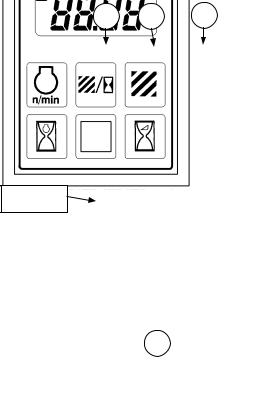
OPERATOR'S STATION
Mac-Monitor: PROGRAMMING (continued)
4.Once the desired programming mode is displayed, enter the selection mode by pressing and holding switch (A) for more than 5 seconds. (At 5 seconds there will be an audible tone. Release switch at tone.)
5.In the “ENG/SI” selection mode the monitor shows “ENG” or “SI”, whichever unit of measure is active. To scroll between the two, momentarily push switch (A). “SI” will cause cutting rate and cut area totals to display in hectares. As well, the speedometer will display in kilometers per hour. When in “SI”, the small triangle at the top left corner of the digital display will be illuminated. “ENG” will cause cutting rate and cut area totals to display in acres and the speedometer to display in miles per hour. Shipping Position = ENG.
6.To select either “ENG” or “SI” once it is displayed, press and hold switch (A) for more than 5 seconds. (At 5 seconds there will be an audible tone. Release switch at tone.) This also advances the monitor to the next programming mode (CUT WIDTH).
7.Press switch (A) for 5 seconds again to enter the “CUT WIDTH” selection mode. The monitor shows the active cut width. To scroll through the cut widths, momentarily press switch (A) to scroll in 0.5 foot increasing increments through a cutting range of 10.0 to 37.0 feet (3.05 to 11.28 meters). Display in feet will have an “F” following the width, e.g. 24.5 feet cutting width would be shown as “24.5F”. Shipping Position = 10.0F NOTE: To advance the cut width in increments of 5 feet instead of 0.5, turn the header drive switch on and off again (see page 23).
8.To select a cut width once it is displayed, press and hold switch (A) for more than 5 seconds. (At 5 seconds there will be an audible tone. Release switch at tone.) This also advances the monitor to the next programming mode (TIRE SIZE).
9.Press switch (A) for 5 seconds again to enter the “TIRE SIZE” selection mode. The monitor shows the active tire size. Momentarily press switch (A) to scroll through tire options. This selection will trigger the correct readout for speedometer, based on rolling diameter of each tire size. Shipping Position = 21.5. NOTE: For units with 500 series tires, select the “500” option.
10.To select a tire size once it is displayed, press and hold switch (A) for more than 5 seconds. (At 5 seconds there will be an audible tone. Release switch at tone.) This also returns the monitor to the “ENG/SI” programming mode.
11.To save the settings into memory and return the monitor into the normal working mode, turn the key to the “off” position and back on again. This can be done from any of the three main programming modes (ENG/SI, CUT WIDTH, TIRE SIZE), but not from the selection mode within any of these.
Mac-Monitor Machine Warning System:
Consists of individual lights to indicate low engine oil pressure, low transmission oil pressure and park brake on. An audible tone will sound whenever one of the indicator lights is on. In addition, the tone will sound when a high engine coolant temperature is indicated.
ENGINE OIL PRESSURE LIGHT (G):
Both light and tone will be activated when ignition switch is turned ON if engine oil pressure is below 11 psi (75 kPa). If light and tone stay on for more than a few seconds after engine starts, or if they activate while engine is running, shut engine off and check engine oil level.
TRANSMISSION OIL PRESSURE LIGHT (H):
Both light and tone will be activated when ignition switch is turned ON if transmission oil pressure is below 150 psi (1035 kPa) for Turbo or 40 psi (275 kPa) for Naturally Aspirated engine. Do not drive the windrower until light and tone go off. If light and tone stay on after engine starts, or if they activate during operation, shut engine off and check hydraulic oil level at reservoir. If oil level is adequate, measure supercharge relief pressure. See "Traction Drive: Hydraulics" in Maintenance/ Service section.
PARKING BRAKE LIGHT (J):
Both light and tone will be activated when ignition switch is turned to ON as a reminder to release brake before driving windrower. Release of brake de-activates light and tone. Light and tone will not activate with transmission in neutral.
G H J
SI
INDICATOR
A
Form # 46584 |
18 |
Issue 11/06 Web Rev_01 |
|
|

OPERATOR'S STATION
Operator Presence System
Requires the operator to be seated in the seat in order to engage the header drive. Should the operator leave the seat with the header drive engaged, power is maintained to the header drive for 5 seconds, after which the header is shut off. NOTE: If the operator leaves the seat for more than 5 seconds and then sits down again, the operator must move the header engage switch to “OFF” position and back to the “ON” position again to restart the header.
Gauges
FUEL GAUGE (A) - Indicates fuel level in tank. Check fuel gauge before beginning day's operation. Stop to refuel before fuel gauge reaches empty mark. Use fuel specified under "Fuels, Fluids and Lubricants" in Maintenance/ Service section.
Should engine run out of fuel and not start in several tries, air must be bled from the fuel system. See "Fuel System Air Removal" in Maintenance /Service section.
VOLT METER (B) - Indicates condition of battery and alternator. With key switch in the ON position and the engine NOT running, a reading of 12 indicates fully charged battery. Watch for changes in the volt reading:
|
|
Reading |
Indicated |
(engine running) |
Condition |
|
|
14 |
normal |
|
|
over 16 |
regulator misadjusted |
|
|
under 12 |
alternator not working or |
|
regulator misadjusted |
|
|
ENGINE TEMPERATURE GAUGE (C) - Monitors the temperature of engine coolant. With engine running, temperature gauge should read in the
180° - 225°F operating range (82° - 107°C). Allow engine temperature to rise to this range before beginning operation. If gauge reaches
approximately 225°F (107°C) a warning tone will sound. Stop engine immediately and determine cause. (See Trouble Shooting section.)
NOTE: If a tone sounds when engine temperature
is below 225°F (107°C) and no indicator light illuminates [(G), (H) or (J) on Mac-Monitor, page 18], check bulbs.
Speedometer
The speedometer (D) indicates vehicle speed in miles per hour or kilometres per hour. Programming to switch between miles and kilometres is done at the Mac-Monitor (see previous page). An arrow in top left corner of display indicates kilometres per hour is currently displayed.
D
SPEEDOMETER
A
B
C
GAUGES
Form # 46584 |
19 |
Issue 11/06 Web Rev_01 |
|
|

OPERATOR'S STATION
Ignition Switch
The ignition switch (A) has three positions; OFF, RUN and START.
The furthest counter-clockwise position of the key is OFF. Turn key fully clockwise to START. Holding key in this position will cause engine to crank.
Release of key will return to the vertical RUN position.
Lights
LIGHT SWITCH (B) - The light switch has four positions:
1.OFF - Furthest counter-clockwise position. To turn off all lamps.
2.FLASHER - To turn on flashing amber lamps and red tail lamps. (For use when windrower is being hauled by a towing vehicle.)
3.ROAD - To turn on head lamps, flashing amber lamps and red tail lamp. (For driving on roadways.)
4.FIELD - To turn on head lamps and field lamps. For field use ONLY.
CAUTION: When operating on a roadway, switch to the ROAD position. Never use field lamps or any lights which might confuse other
drivers. Always use flashing amber lamps when driving or hauling on roadways, unless prohibited by law.
TURN SIGNAL SWITCH (C) - When operating windrower on a roadway, use turn signals as you would in a car or truck.
Turn signals will work with flashers on or off. Moving switch to left or right will flash turning side lamps with other side steady. An audible signal (beeper) will sound when turn signal switch is activated.
Turn indicators (D) are located on headliner.
NOTE: Be sure to return switch (C) to center position after turning.
DOME LIGHT (E) - Pushing button on dome light turns light ON and OFF
REAR VIEW MIRRORS (F) - Adjust mirrors for best view.
A
C
B
IGNITION SWITCH AND LIGHTS
D
TURN INDICATORS
E
DOME LIGHT - RIGHT REAR CORNER
F
REAR VIEW MIRRORS
Form # 46584 |
20 |
Issue 11/06 Web Rev_01 |
|
|

OPERATOR'S STATION
Cab Temperature Controls
NOTE: For access to circuit breakers, relays, fuses and other electrical components in cab side console, remove panel on window side of console.
BLOWER SPEED SWITCH (A) - Controls operation of blower. Four positions are: OFF, LOW, MEDIUM and HIGH. The blower recirculates cab air as well as drawing in outside air to pressurize the cab.
With door and window closed and blower on, dust and dirt will be filtered out to keep cab interior clean. Adjust louvers (B) (both sides of cab) to direct air where needed, for example, to defog window.
AIR CONDITIONING TEMPERATURE CONTROL
(D) - Air conditioning is OFF when control (D) is turned fully counter-clockwise. Turning control clockwise decreases cab temperature. Blower switch (A) must also be turned ON before air conditioning system will operate.
Regulate cab temperature with air conditioning control and blower speed.
IMPORTANT: If humidity is high it may be necessary to run blower at HIGH speed to prevent evaporator freeze up.
HEATER TEMPERATURE CONTROL (E) -
Heater is off when control (E) is turned fully counter-clockwise. Turning control clockwise increases cab temperature. Regulate cab temperature with heater control and blower speed.
NOTE: Heat and air conditioning systems are independent of each other. To avoid working one system against the other, be sure the system not in use is turned OFF at the appropriate temperature control, unless both are required to defog windows. There is also a shut-off valve for the heater circuit at the engine. Valve must be open for heater to function. For maximum cooling in hot conditions, close valve (G).
NOTE: If windows fog up, run the air conditioning to dehumidify the cab air, plus the heater to control cab temperature.
Windshield Wiper Control
Control windshield wiper using knob (F).
F
D A E
CAB TEMPERATURE AND
WIPER CONTROLS
B
B
DIRECT AIR FLOW WITH LOUVERS
G
HEATER SHUT-OFF VALVE
Form # 46584 |
21 |
Issue 11/06 Web Rev_01 |
|
|

OPERATOR'S STATION
Windrower Controls
VARIABLE GROUND SPEED CONTROL LEVER
(A) Controls windrower direction of movement and rate of speed. A neutral start switch prevents the starter from engaging unless this lever is in the neutral detent as shown and the steering is locked in the straight-ahead position.
For forward motion: Push lever forward. The further the lever is moved from neutral the faster the speed. Release lever at desired speed and lever will engage friction device to secure the position.
For reverse motion: Pull lever rearward. The further the lever is moved from neutral the faster the speed.
SPEED-RANGE CONTROL (B) (Turbo units) - Shifts the transmission to FIELD (Low) or ROAD (High) speed range.
Field Speed Range: This setting is for windrower operating speeds (0 - 10 mph [16 km/h]). Steering is less sensitive in this range.
Road Speed Range: This setting is for transport speeds (0 to 16 mph [26 km/h]). Steering is more sensitive in this speed range.
C B
A
D 
WINDROWER CONTROLS
THROTTLE LEVER (C) - Push lever forward to increase engine speed (RPM) and rearward to decrease. Full forward is operating RPM.
PARK BRAKE LEVER (D) - Pull up on lever to engage brake. Push down to release.
CAUTION: Use park brake only when windrower is stopped. Do not use park brake to slow windrower when moving. Use variable speed lever to slow and stop machine.
STEERING WHEEL
To adjust steering wheel tilt:
1.Push and hold handle (F) down.
2.Move steering wheel to desired position.
3.Release handle to lock the position.
When exiting cab, push handle (F) down. This returns steering wheel to upright position for easier
exit and re-entry.
F
STEERING WHEEL
Form # 46584 |
22 |
Issue 11/06 Web Rev_01 |
|
|
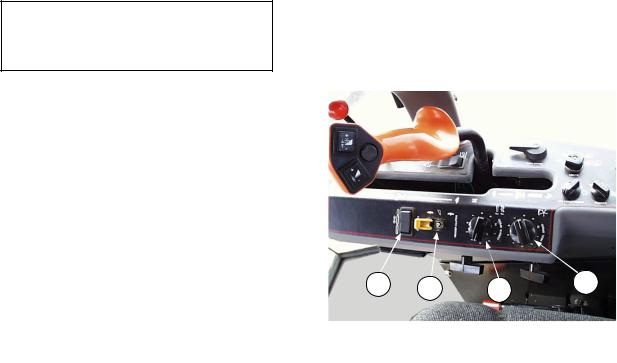
OPERATOR'S STATION
Header Controls
NOTE: Some of these controls are not used for all types of headers. Some are optional equipment and may not be present in your unit. For others, while the switch may be installed, it will be non-functional for certain headers.
HEADER DRIVE SWITCH (A) - Lift the guard to expose toggle switch. Push toggle switch forward to engage all header mechanical and hydraulic drives. Push guard down to disengage drives.
Starter will not engage if switch is in the engaged position.
NOTE: Always move throttle lever back to idle before engaging header drives. Do not engage with engine at full RPM.
CONVEYOR SPEED CONTROL (B) - Turn knob clockwise to increase conveyor speed and counter-clockwise to decrease. Speed range is:
940 Series Headers, Auger speed: 175 - 500 RPM 960/970 Series Headers, Draper speed:
170 to 500 ft/min (50 - 155 m/min)
REEL SPEED CONTROL (C) - Turn knob clockwise to increase reel speed and counterclockwise to decrease. Speed range is:
920 Series Headers: 30 to 75 RPM
930 Series Headers: 30 to 69 RPM 940/960/970 Series Headers: 20 to 60 RPM
NOTE: 920/930 Series Headers – For these headers, both controls (B) and (C) affect reel speed. Set conveyor speed knob (B) to "10" and adjust reel speed knob (C) to obtain desired reel speed.
DECK SHIFT SWITCH (D) – Press left side of rocker switch to shift decks to the left and reverse draper travel. Press right side of switch to shift decks to the right and reverse draper travel. For center delivery, move rocker to center position.
D A B C
HEADER DRIVE / CONVEYOR SPEED / REEL SPEED / DECK SHIFT CONTROLS
Form # 46584 |
23 |
Issue 11/06 Web Rev_01 |
|
|

OPERATOR'S STATION
Header Controls (continued)
REEL HEIGHT SWITCH (E) - Press top of switch to raise reel and bottom to lower. Hold switch until reel reaches desired position.
NOTE: For Auger Headers with Hay Conditioners equipped with Hydraulic Roll Opener cylinders, switch (E) controls the operation of these cylinders.
HEADER HEIGHT SWITCH (F) - Press top of switch to raise header and bottom to lower. Hold switch until header reaches desired position. (See "Cut Height Indicator").
NOTE: Handle may be rotated on lever to allow the operator to position switches (E) and (F) for maximum comfort. To adjust, loosen setscrews on back of handle.
IMPORTANT: Do not continue pressing switches (E) or (F) after header or reel travel is complete. If switch is held for a long period of time, damage may occur due to overheating electrical solenoids and/or over-heating hydraulic oil, which is pumped through relief valve.
E
H
K
F L J
REEL & HEADER HEIGHT SWITCHES REEL FORE-AFT & HEADER TILT CONTROLS
HEADER EXPRESS DOWN
(Optional) – This dealer installed option is operated from switch (G). To activate the express down function, set switch (G) to “front down” position as shown. In this mode, it is not necessary to hold header height switch (F) to lower header fully. A momentary touch and release of the “down” side of switch (F) will fully retract header lift cylinders. To stop express down function in mid-travel, touch and release the “up” side of switch (F).
To bypass the express down function, set switch
(G) to “rear down” position. Header height switch
(F) will then operate as described at top of page.
REEL FORE-AFT CONTROLS (H) & (J) (Optional) – For headers with hydraulic reel foreaft option. Press button at (H) to move reel forward. Press button at (J) to move reel rearward.
HEADER TILT CONTROLS (K) & (L) (Optional) – Press button at (K) to tilt header back for a flatter guard angle. Press button at (L) to tilt header forward for a steeper guard angle.
G
HEADER EXPRESS DOWN SWITCH
Form # 46584 |
24 |
Issue 11/06 Web Rev_01 |
|
|
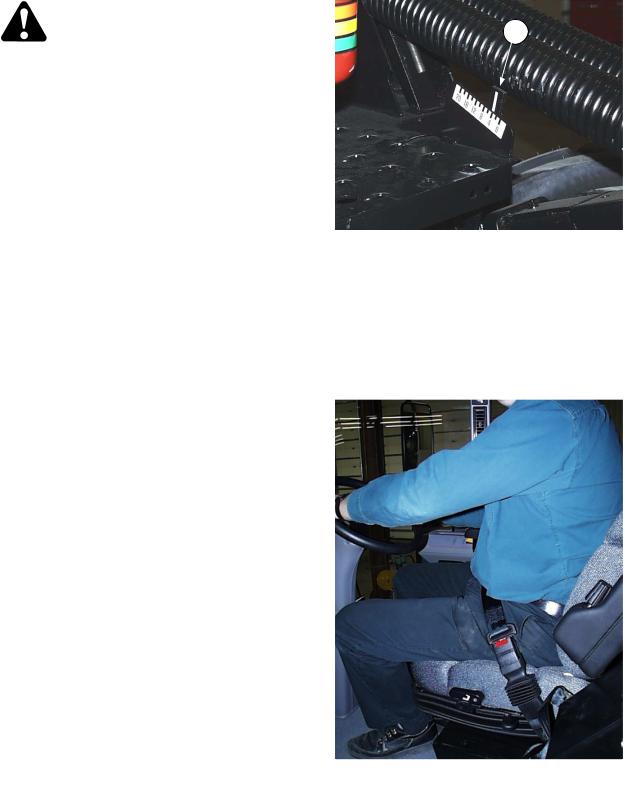
OPERATOR'S STATION
Header Controls (continued)
CUT HEIGHT INDICATOR (G) - The gauge on the lift linkage can be used to identify desired cut heights.
G
With the center link (between tractor and header) in a mid-range position, the numbers on the gauge indicate approximate cut (stubble) height in inches. Adjusting center link length will affect the starting point; eg. gauge reading 4 may indicate a 3" (longer center link) or 5" (shorter center link) cut height. However, the difference between gauge readings of 4 and 8, 8 and 12, etc. will always be about 4 inches, regardless of center link length.
Header Angle: Cut height indicator (G) can also be used to identify header angle when cutting with header on the ground. The gauge indicator will
decline until header contacts ground, then as CUT HEIGHT INDICATOR header height switch is held in down position, the
indicator reading will increase as header angle steepens. The gauge numbers will not correspond to actual header angle, but can be used to identify a desired setting. See "Header Angle" in Operation section for adjustment procedure.
Seat Belts
The windrower is equipped with a seat belt on the
Operator’s and Trainer’s seats.
WARNING: Before starting engine, securely fasten your seat belt and ensure trainer’s seat belt is fastened
if occupied. The seat belt can help insure your safety if it is used and maintained. Never wear a seat belt loosely or with slack in the belt system. Never wear the belt in a twisted condition or pinched between the seat structural members.
To fasten seat belt, pull belt completely across your body. Push the metal eye into the buckle until it locks. Adjust the position of the belt as low on your body as possible.
To release, push the red button in the end of the buckle and separate the buckle and metal eye.
SEAT BELT
Form # 46584 |
25 |
Issue 11/06 Web Rev_01 |
|
|
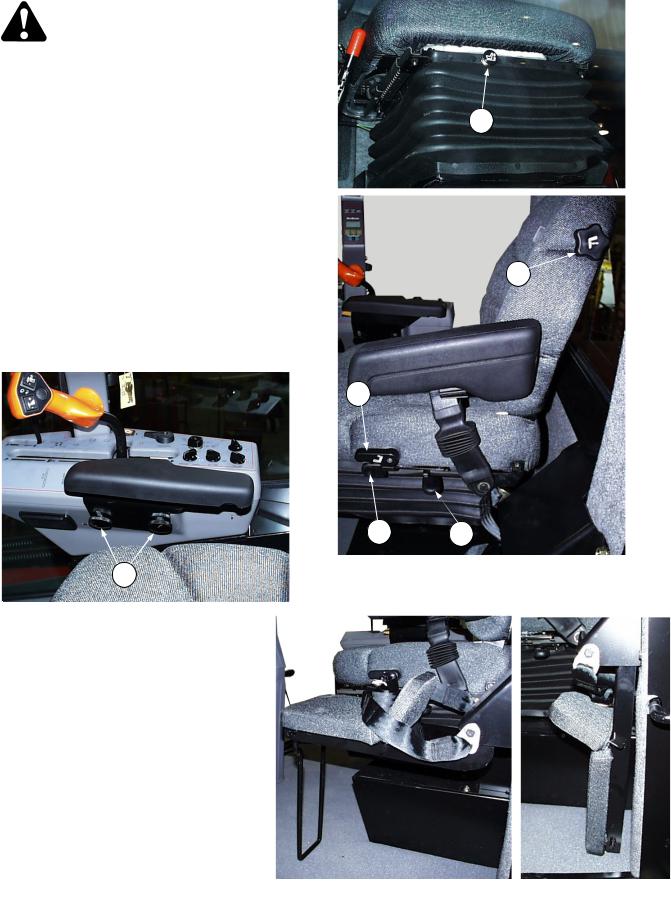
OPERATOR'S STATION
Seat Adjustments
OPERATOR WEIGHT & SEAT HEIGHT ADJUSTMENT - Press knob (A) in to increase suspension stiffness and seat height. Pull knob out to decrease.
SEAT-BACK ANGLE - Pull up on lever (B), position seat back as desired, and release lever.
LUMBAR SUPPORT - Rotate knob (C) to position lumbar support as desired.
SEAT FORE-AFT POSITION - To adjust, pull out on lever (D), move seat forward or rearward to desired position and release lever.
SEAT FORE-AFT ISOLATOR LOCKOUT - To lock out fore-aft isolator, push down on lever (E).
ARM RESTS – Left arm rest has two positions, vertical and horizontal. Raise left hand arm rest when leaving seat for easier exit and re-entry.
Right arm rest is mounted on side console and is adjustable vertically at nuts (F) to operator preference.
F
RIGHT ARM REST
TRAINING SEAT – Retractable training seat complete with seat belt is provided for use as described below. To extend, raise seat cushion and pivot front support down as shown. For storage, collapse front support and lower seat cushion.
WARNING: The training seat is provided for an experienced operator of the machine when a
new operator is being trained.
The training seat is NOT intended as a PASSENGER SEAT or FOR USE BY CHILDREN.
USE THE SEAT BELT whenever operating the machine or riding as a trainer. KEEP ALL OTHER RIDERS OFF THE MACHINE.
A
C
B
D E
AIR SUSPENSION SEAT
TRAINING SEAT
Form # 46584 |
26 |
Issue 11/06 Web Rev_01 |
|
|
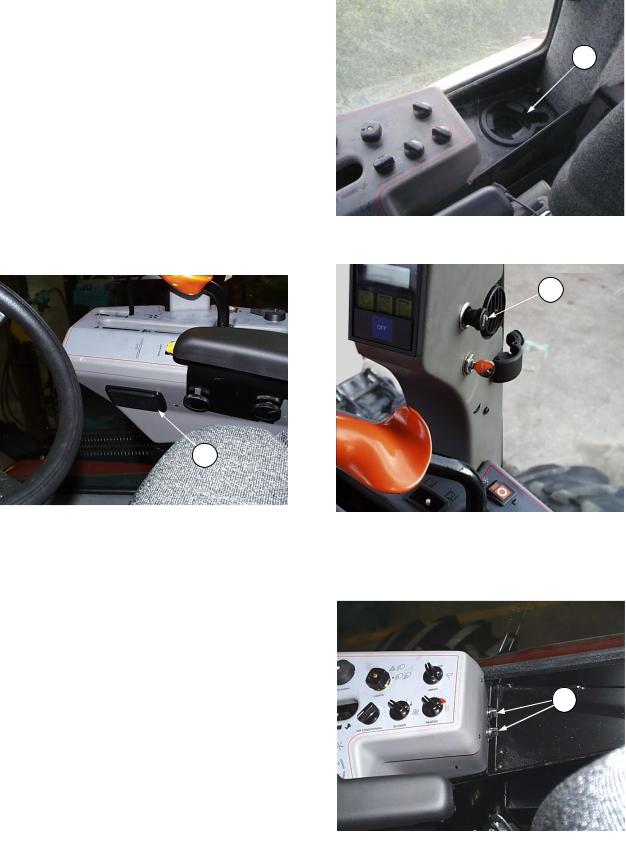
OPERATOR'S STATION
Operator Amenities
CUP HOLDER (A) – Provided at side console.
A
CIGARETTE LIGHTER (B)
CUP HOLDER
ASHTRAY (C)
B
C
LIGHTER & ASHTRAY
AUXILIARY POWER POINTS (D) - Two 12 volt power outlets are provided on backside of console.
D
POWER POINTS
Form # 46584 |
27 |
Issue 11/06 Web Rev_01 |
|
|

OPERATION
Your Responsibilities as an Owner/Operator
CAUTION:
1.It is your responsibility to read and understand this manual and the Header Operator's Manual completely before operating the windrower. Contact your dealer if an instruction is not clear to you.
2.Follow all safety messages in the manuals and on safety signs on the windrower.
3.Remember that YOU are the key to safety. Good safety practices protect you and the people around you.
4.Before allowing others to operate the windrower, for however short a time or distance, make sure they have been instructed in its safe and proper use.
5.Review the manuals, safety signs and all safety related items with all operators annually.
6.Be alert for other operators not using recommended procedures or not following safety precautions. Correct these mistakes immediately, before an accident occurs.
7.Maintain the windrower correctly. Be sure all controls are functioning properly before use.
8.Do not modify windrower or remove shields. Unauthorized modifications may impair the function and/or safety and affect machine life.
9.Install a fire extinguisher and keep it properly charged.
10.The safety information given in this manual does not replace safety codes, insurance needs or laws governing your area. Be sure your windrower meets the standards set by these regulations.
To the New Operator
It's natural for an operator to be anxious to get started with a new machine. Please take the time to familiarize yourself with the windrower by reading the Operator's Manuals and safety signs before attempting operation. Study the Starting, Driving and Stopping procedures so you will know what to expect.
Form # 46584 |
28 |
Issue 11/06 Web Rev_01 |
|
|
